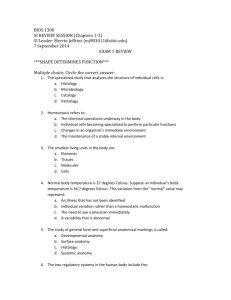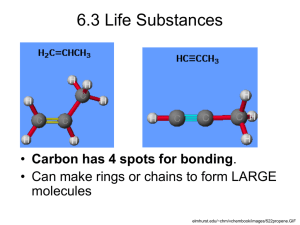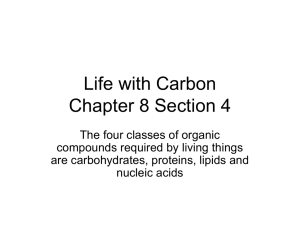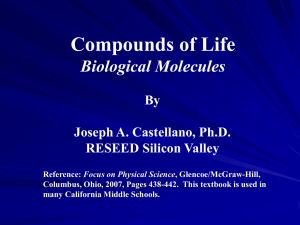1. Intro to Chemistry and Polymers Power-point
advertisement
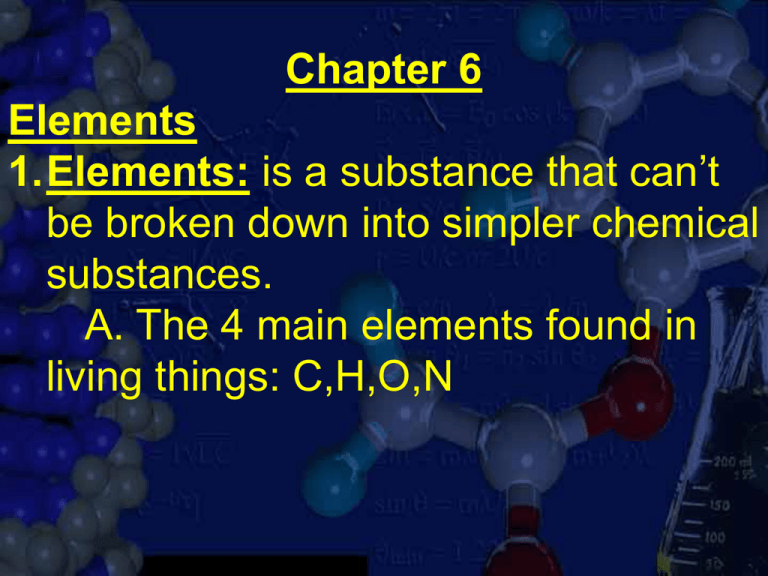
Chapter 6 Elements 1.Elements: is a substance that can’t be broken down into simpler chemical substances. A. The 4 main elements found in living things: C,H,O,N Chapter 6 Elements 1. Carbon: long carbon chains make up the backbone for Proteins, Lipids, Carbohydrates, and Nucleic Acids. *Any molecule that contains carbon is called an organic molecule. Chapter 6 Elements 2 and 3. Oxygen and Hydrogen are also found in Proteins, Lipids, Carbohydrates, and Nucleic acids, as well as make up water. 4. Nitrogen is found in both Proteins and Nucleic Acids. Chapter 6 2. Atom: the smallest particle of an element that has the characteristics of that element. Chapter 6 ATOMS BOND TOGETHER TO FORM COMPOUNDS COMPOUND: A substance that is composed of atoms of two or more different elements that are chemically combined. Ex. H20, water is made up of Hydrogen and Oxygen. 2 H+O= H2O Writing Chemical Formulas: 2H2 +O2 2H2O Reactants Products A. The number in front of the atom or molecule tells you how many of each you have. B. The subscript number tells you how many of that kind of atom is in a certain molecule. Types of Bonds: 1. Covalent Bonds: When two atoms share an electron to form a bond. Ex. H2O A. Molecule: a group of atoms held together by covalent bonds. Types of Bonds: 2. Ionic Bond: a bond where one positively charged ion takes an electron from a negatively charged ion. Ex. Na+and Cl- form NaCl Types of Bonds: 3. Hydrogen Bond: a weak magnetic bond between the opposite poles of two polar molecules: Ex. Water A. Water is Polar because electrons shared in covalent bonds of molecules are not always shared equally resulting in a polar molecule with a partial positive pole and a partial negative pole. Types of Bonds: B. Polar Molecule: a molecule with an unequal distribution of charge. Ex. H2O. As a result of this polarity: *Water can dissolve many ionic compounds. Ex. Salt and Sugar **Water molecules attract other water molecules, forming a Hydrogen Bond. This gives Water great stability. ***Hydrogen Bonds Also helps hold together many large molecules, such as proteins and DNA. ORGANIC MACROMOLECULES Atoms bond together to form Molecules and then Molecules bond together to form Polymers. 1. Polymer/Macromolecule: is a large molecule formed when smaller molecules bond together. * The four macromolecules that make up living things are: 1. Carbohydrates 2. Lipids 3. Proteins 4. Nucleic Acids I. Carbohydrate: is an organic compound made of C,H, and O with a 2:1 Hydrogen : Oxygen ratio. 1. Molecular Building Blocks: Monosacharides (simple sugars) like glucose and fructose bond together to form Polysaccharides (complex carbohydrates and starches). Monosaccharide (Monomer) Disaccharides Disaccharides Polysaccharide (Polymer) 2. Function: It is mostly used as a source of energy for the body. Ex. Mammals store food in the liver in the form of glycogen, a glucose polymer. 3. Examples: Carbohydrates can be found in pasta, potatoes, cereal, anything made of grain or corn, and simple sugars. II. Lipids: organic compounds that have a large proportion of C-H bonds and less oxygen than carbohydrates. 1. Molecular Building Blocks: Glycerol (Alcohol) Fatty Acids 2. Function: Cell use lipids for energy storage, insulation, and a protective coating. Lipid Structure 3. Examples: Lipids can be found in oils, butter and other dairy products, meat products, and nuts. III. Protein: A large complex polymer made of C, H, O and N. 1. Molecular Building Blocks: Amino Acids are the Building blocks of protein. There are 20 in nature. Amino Acid + Amino Acid etc…= Protein A. Peptide Bonds: The covalent bonds between Amino Acids in a protein. 2. Function: A. Proteins provide the structure for living things (Growth and Repair) B. Proteins called Enzymes speed up and controls all of the chemical reactions in living things. C. Enzymes can become denatured (damaged) and as a result, stop working when exposed to too high or too low temperatures and pH. * Acids and Bases: ph: is a measure of how acidic or basic a solution is. The scale ranges from 0-14. A pH of 7 is neutral Base: any substance that forms hydroxide ions (OH-) in water and has a pH above 7 with 14 being the most basic. Acid: any substance that forms hydrogen ions (H+) in water and has a ph below 7 with 0 being the most acidic. Examples of pH and Temperature affecting Enzymes: Temp: Human enzymes work best at a temperature around 98.6 degrees F. High fevers can denature enzymes, slow down chemical reactions, and as a result, even kill the individual. pH: Pepsin a human stomach enzyme works best at a pH of 2 but don’t work in the Small Intestine with a pH of 8. 3. Examples: Proteins can be found in meat, beans, nuts, eggs etc… IV. Nucleic Acids: a complex molecule that stores cellular information in the form of a code. Ex. DNA and RNA. 1. 1. Molecular Building Blocks: Nucleotides: The building blocks of Nucleic Acids. 2. Function: They store information in code and contain all of the instructions used to form all of an organism’s enzymes and structural proteins. DNA RNA Protein Trait Organic Macro Molecule/ Polymer Carbohydrate Molecular Building Blocks Function in Living Things How to Detect Monosacharides Energy Sugar: Brick-Red Precipitate in Benedict’s solution Starch: Iodine (BlueBlack) Lipid Energy Storage Glycerol Insulation and Protection Fatty Acids Structure and Amino Control Chemical Acids Reactions Protein Nucleic Acid Nucleotides DNA RNA Protein Trait Translucent Brown Paper Bag Biuret’s solution turns purple Organic Macro Molecule/ Polymer Molecular Subunits/ Monomer Function in Living Things Foods 1. A. B. D. 2. A. B. D. 3. A. B. D. 4. A. B. D.


